Research at CMRR
For Investigators Heading link
-
Currently Funded Research
- Ross (MD) (GLCT)
- W8M-MC-CWMM (OXA1) (42717) (Eli Lilly)
- A Phase 2b, Double-Blind Study to Investigate the Effect of LY3437943 on Renal Function in Participants with Overweight or Obesity and Chronic Kidney Disease with or without Type 2 Diabetes (J11-MC-GZBU)
- I5T-MC-AACM (Eli Lilly)
- Janssen Autonomy Study
- Green Memory Study
- Manish Jain (MD) – A Randomized, Double-Blind, Placebo-Controlled, Multi-Center, Phase 3 Study to Determine the Efficacy of TG-C in Subjects with Kellgren and Lawrence Grade 2 or 3 Osteoarthritis of the Knee.
- Anand Srivastava (MD) – Advancing Kidney Functional MRI in Patients with Sickle Cell Disease.
- Alexandra Aaronson (PhD) – Neuromodulation for impulsivity and suicidality in Veterans with mild TBI and common co-occurring mental health conditions.
- James Lash (MD) – Kidney Imaging Network (KIN): Advancing Kidney Functional Magnetic Resonance Imaging in Chronic Kidney Disease.
- Cemal Yazici (MD) – IMMINENT
- Jun Ma (PhD) – Study of a PST-Trained Voice-Enabled Artificial Intelligence Counselor (SPEAC) for Adults with Emotional Distress (Phase 2).
- Joan Ann O’Keefe() – Neural underpinnings of cognitive, balance and gait deficits in Huntington’s disease.
- Muge Karaman (PhD) – Comprehensive Characterization of Heterogeneous Breast Tissue from a Broad b-value Spectrum Using Multi-modal Diffusion MRI.
- Tanvi Bhatt (PhD) – Cognitive motor training in frail older adults.
- Sangeetha Madhavan (PhD) – Cortical priming to optimize gait rehabilitation.
- Natania Crane (PhD) – Brain-Behavior Markers of Reward and Cannabis Abuse Risk in Young Adults.
- Michael Abern, M.D. – Prostate Cancer Detection Using a Quantitative Screening MRI Protocol
- Olu Ajilore, M.D., Ph.D.
- Improving white matter integrity with thyroid hormone
- UnMASCK
- REMBRANDT
- Tanvi Bhatt, Ph.D. – Virtual-reality based Cognitive-motor-balance (VR-CogMoBal) training
- Katie Burkhouse, Ph.D.
- Brain-Behavior Predictors of Prevention Response among Offspring of Depressed Mothers
- Brain and Behavioral Measures of Affect and Motivational Reactivity in Daughters and their Mothers
- Brain-Behavior Markers Of Emotion In Depressed Mothers And Their Daughters
- Martha Daviglus, M.D., Ph.D.
- Hispanic Community Health Study – Study Of Latinos (HCHS-SOL) – Field Center
- Non-Alcoholic Fatty Liver Disease And Cardiovascular Disease In Hispanics/Latinos (Dr. Jorge Kizer)
- Study of Latinos – Investigator of Neurocognitive Aging II (Dr. H. Gonzales)
- Frank Gonzalez, M.D. – Treating Inflammation in PCOS to Ameliorate Ovarian Dysfunction
- Jeffrey Ross, M.D.
- AgeneBio AGB 101 MCD
- T2 Biohaven Alzheimer’s BHV4157-203
- EXERT Study
- Lisanne Jenkins, Ph.D. – Multimodal brain network predictors of relapse in depression
- Heide Klumpp, Ph.D. – Transdiagnostic Brain-Behavior Profiling to Enhance Cognitive Behavioral Therapy Response
- Jeff Kordower, Ph.D. – Genetic Silencing of Striatal CaV1.3 Calcium Channels as a Potent Antidyskinetic Therapy for PD
- Andreas Linninger, Ph. D– A Vascular Tree Topology Inspired Platform to Compute Intracranial Blood Flow
- Jun Ma, MD, Ph.D., FAHA, FABMR – Engaging self-regulation targets to understand the mechanisms of behavior change and improve mood and weight outcomes
- Pauline Maki, Ph.D. – Stellate Ganglion Blockade for the Management of Vasomotor Symptoms
- Jonathan Stange Ph.D. – From networks to the real world: Integrating neural and autonomic processes of loss
- Fernando Testai, M.D., Ph.D., FAHA – A Global, Phase 2, Randomized, Double-Blind, Placebo-Controlled, Response-Adaptive Dose- Ranging Study of BMS-986177, an Oral Factor XIa Inhibitor, for the Prevention of New Ischemic Stroke or New Covert Brain Infarction in Patients Receiving Aspirin and Clopidogrel Following Acute Ischemic Stroke or Transient Ischemic Attack (TIA)
- Krista Varady, Ph.D. – Alternate day fasting combined with exercise for the treatment of NAFLD
- Xiaohong Joe Zhou, Ph.D.
- Probing lntra-voxel Tissue Heterogeneity Using MRI
- Transition from Acute to Chronic Pain in Total Knee Arthroplasty Patients: Identifying Resilience and Vulnerability Profiles
- Establishing an MRI Protocol for Detecting Hemorrhagic Lesions in Human Pancreas
- Technical Development for Advanced MRI Data Acquisition
- NIH-funded Acute to Chronic Pain Signatures (A2CPS) Program (A2CPS)
Advanced Imaging Center: 2242 West Harrison Street, Chicago, Illinois.
-
Cancer Imaging
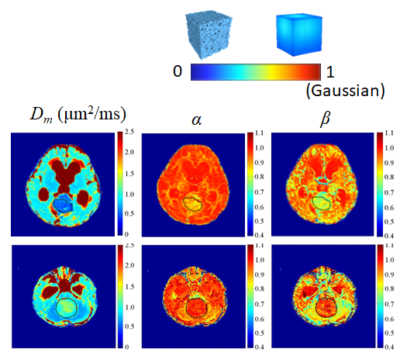
Advanced Diffusion-Weighted Imaging with Fractional Order Calculus (FROC) and Continuous-time Random Walk (CTRW) Models
Given the heterogeneous nature of biological tissues which exhibit a high degree of structural heterogeneity and complexity, it is well known that water diffusion in tissues does not follow a Gaussian distribution. The FROC diffusion model captures this tissue complexity by for characterizing not only the diffusion process itself (D), but also the tissue structures (β and μ) through which water molecules diffuse. The CTRW diffusion model, which is an extension to the FROC model, recognizes intravoxel diffusion heterogeneity in both time (i.e., water molecules can take a variable amount of time to make a move, which we call “water trapping”) and space (i.e., water molecules can diffuse with drastically different free length, which we call “water jumping”). These diffusion heterogeneities (α and β) can directly reflect intravoxel structural heterogeneity, which is related to tissue complexity and microenvironment.
Our group has been investigating the feasibility of FROC and CTRW diffusion models in probing the underlying tissue characteristics in different disease conditions and organs, including adult and pediatric brain tumors, gastric cancer, and bladder cancer.
Related Publications
- Karaman MM, Zhou CY, Zhang J, Zhong Z, Wang K, Zhu W. Percentile-based Analysis of Non-Gaussian Diffusion Parameters for Improved Glioma Grading. Investigative Magnetic Resonance Imaging 2022. Manuscript No. 21-414 (accepted).
- Feng C, Wang Y, Dan G, Zhong Z, Karaman MM, Li Z, Hu D, Zhou XJ. Evaluation of a fractional-order calculus diffusion model and bi-parametric VI-RADS for staging and grading bladder urothelial carcinoma. Eur Radiol. 2022 Feb;32(2):890-900. doi: 10.1007/s00330-021-08203-2. Epub 2021 Aug 3. PubMed PMID: 34342693.
- Dan G, Li W, Zhong Z, Sun K, Luo Q, Magin RL, Zhou XJ, Karaman MM. Diffusion in Sephadex Gel Structures: Time Dependency Revealed by Multi-Sequence Acquisition over a Broad Diffusion Time Range. Mathematics (Basel). 2021 Jul 2;9(14). doi: 10.3390/math9141688. Epub 2021 Jul 19. PubMed PMID: PMC8356480.
- Karaman MM, Zhang J, Xie K, Zhu W, and Zhou XJ. Quartile Histogram Assessment of Glioma Malignancy Using High b-Value Diffusion MRI with a Continuous-Time Random-Walk Model. NMR Biomed 2021; e4485.
- Karaman MM, Tang L, Li Z, Sun Y, Li JZ, Zhou XJ. In vivo assessment of Lauren classification for gastric adenocarcinoma using diffusion MRI with a fractional order calculus model. Eur Radiol. 2021 Aug;31(8):5659-5668. doi: 10.1007/s00330-021-07694-3. Epub 2021 Feb 22. PubMed PMID: 33616764.
- Zhang J, Weaver TE, Zhong Z, Nisi RA, Martin KR, Steffen AD, Karaman MM, Zhou XJ. White matter structural differences in OSA patients experiencing residual daytime sleepiness with high CPAP use: a non-Gaussian diffusion MRI study. Sleep Med. 2019 Jan;53:51-59. doi: 10.1016/j.sleep.2018.09.011. PubMed PMID: 30445240; PubMed Central PMCID: PMC6360120.
- Zhong Z, Merkitch D, Karaman MM, Zhang J, Sui Y, Goldman JG, Zhou XJ. High spatial resolution diffusion MRI of Parkinson disease: lateral asymmetry of the substantia nigra. Radiology. 2019 April; 291(1):149-157. PubMed Central PMCID: PMC6438360; PubMed PMID: 30777809; doi: 10.1148/radiol.2019181042.
- Tang L, Sui Y, Zhong Z, Damen FC, Li J, Shen L, Sun Y, Zhou XJ. Non-Gaussian diffusion imaging with a fractional order calculus model to predict response of gastrointestinal stromal tumor to second-line sunitinib therapy. Magn Reson Med. 2018 Mar;79(3):1399-1406. doi: 10.1002/mrm.26798. PubMed PMID: 28643387; PubMed Central PMCID: PMC5741547.
- Sui Y, Xiong Y, Jiang J, Karaman MM, Xie KL, Zhu W, and Zhou XJ. Differentiation of Low- and High-Grade Gliomas Using High b-Value Diffusion Imaging with A non-Gaussian Diffusion Model. AJNR: Am J Neuro Radiol2016. 2016;37(9):1643–9; PMID:27256851.
- Sui Y, Wang H, Liu G, Damen FW, Wanamaker C, Li Y, Zhou XJ. Differentiation of Low- and High-Grade Pediatric Brain Tumors with High b-Value Diffusion-weighted MR Imaging and a Fractional Order Calculus Model. Radiology 2015. 277(2):489-96. PMID: 26035586.
- Karaman MM, Sui Y, Wang H, Liu G, Magin RL, Li Y, Zhou XJ. Differentiating Low- and High-Grade Pediatric Brain Using a Continuous-Time Random-Walk Diffusion Model at High b-Value. Magn Reson Med 2015. 76(4): 1149-1157. PMID: 26519663.
Comprehensive Characterization of Breast Tissue Using Multi-Modal MRI
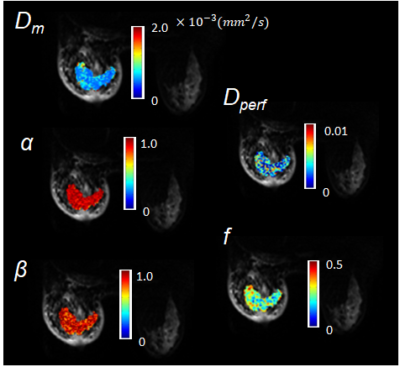
The breast tissue consists of distinct cell types and shapes, membrane permeabilities, and others. As a result, the diffusion pattern of water molecules is influenced by the local heterogenous tissue microstructure. While conventional diffusion-weighted imaging is inadequate to discriminate between the various mechanisms contributing to water mobility, tissue heterogeneity-sensitive models which typically require high b-values, such as the continuous-time random-walk model, has been shown to be feasible in studying the brain microstructures. Despite the increasing interest from the breast imaging community, expansion of advanced diffusion-weighted imaging techniques from the brain to the breast has not been fully achieved.
Our group has been working on developing imaging tools to enable a comprehensive characterization of breast tissue. These tools include novel pulse sequences and integrated multi-modal MRI analysis framework for the breast.
-
Fast fMRI with high spatial resolution over a focused brain volume
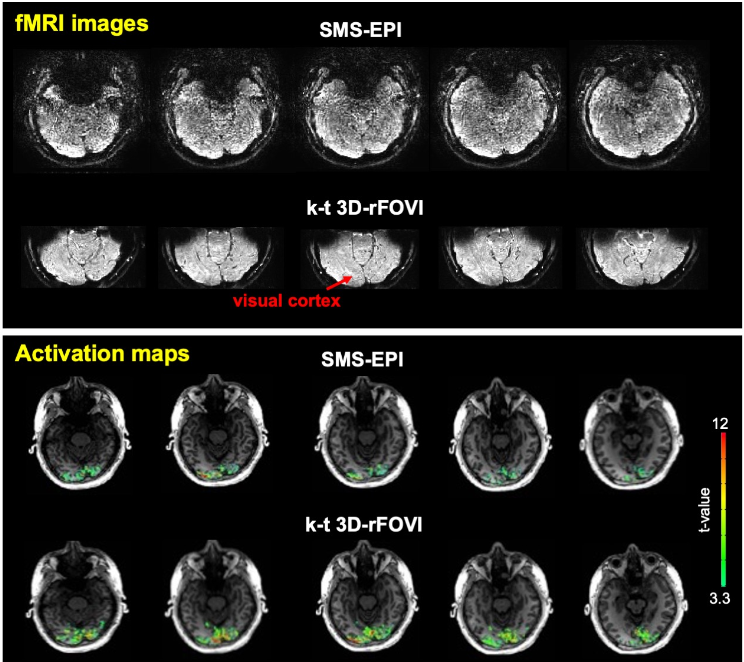
This project aims to develop fast fMRI acquisition (volume TR < 1 sec) techniques for imaging a small brain area with high spatial resolutions (< 2 mm). Currently, simultaneous multi-slice EPI (SMS-EPI) is the mainstream acquisition technique used in fast fMRI studies. However, the image quality of SMS-EPI can be substantially degraded when imaging a small brain volume (e.g., visual cortex) because the receiver coil cannot provide enough sensitivity variations for effectively separating the aliased voxels. In this study, we develop a new fast fMRI acquisition technique that integrates the (k, t)-space undersampling method into the three-dimension reduced field-of-view imaging (3D-rFOVI). Through human fMRI experiments in the visual cortex, we demonstrate that the k-t 3D-rFOVI technique can achieve a volume TR of 800-millisecond and spatial resolution of 1.5-mm-isotropic in fMRI data acquisition over a focused imaging area (192 x 96 x 48 mm3). More importantly, k-t 3D-rFOVI provides higher fMRI image quality than SMS-EPI and considerably improves the detection sensitivity of brain activations.
SPEEDI MRI Sub-millisecond temporal resolution
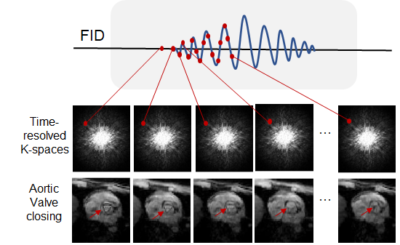
In the SPEEDI method a series of acquisition is collected with each readout point assigned to a different k-space. Under the assumption that FID acquisition is synchronized with a cyclic event, a series of time-resolved images are assembled with a sampling rate equal to the dwell time.
The echo train version – where a full echo is collected instead of a single point – has been developed, both in gradient echo and spin echo framework. Reduced field of view and k-t under sampling have also been implemented. Applications range from very short eddy current measurement to cardiac valve motion monitoring.
-
3D-rFOVI isotropic high spatial resolution and reduced image distortion

In the SPEEDI method a series of acquisition is collected with each readout point assigned to a different k-space. Under the assumption that FID acquisition is synchronized with a cyclic event, a series of time-resolved images are assembled with a sampling rate equal to the dwell time.
The echo train version – where a full echo is collected instead of a single point – has been developed, both in gradient echo and spin echo framework. Reduced field of view and k-t under sampling have also been implemented. Applications range from very short eddy current measurement to cardiac valve motion monitoring.
Publications
- Sun K, Zhong Z, Dan G, Karaman M, Luo Q, Zhou XJ. Three-dimensional reduced field-of-view imaging (3D-rFOVI). Magn Reson Med. 87:2372– 2379. doi:10.1002/mrm.29121
IP-SMS MRI high spatial resolution and reduced image distortion
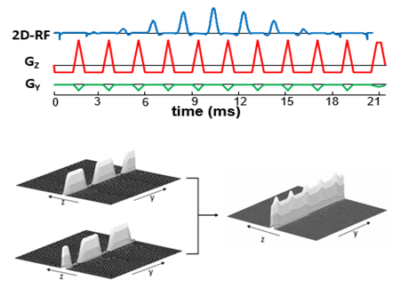
In the SPEEDI method a series of acquisition is collected with each readout point assigned to a different k-space. Under the assumption that FID acquisition is synchronized with a cyclic event, a series of time-resolved images are assembled with a sampling rate equal to the dwell time.
The echo train version – where a full echo is collected instead of a single point – has been developed, both in gradient echo and spin echo framework. Reduced field of view and k-t under sampling have also been implemented. Applications range from very short eddy current measurement to cardiac valve motion monitoring.
Publications
- Sun K, Zhong Z, Xu Z, Dan G, Karaman MM, Zhou XJ. In‐plane simultaneous multisegment imaging using a 2D RF pulse. Magn Reson Med. 2022;87:263–271. DOI: 10.1002/mrm.28956